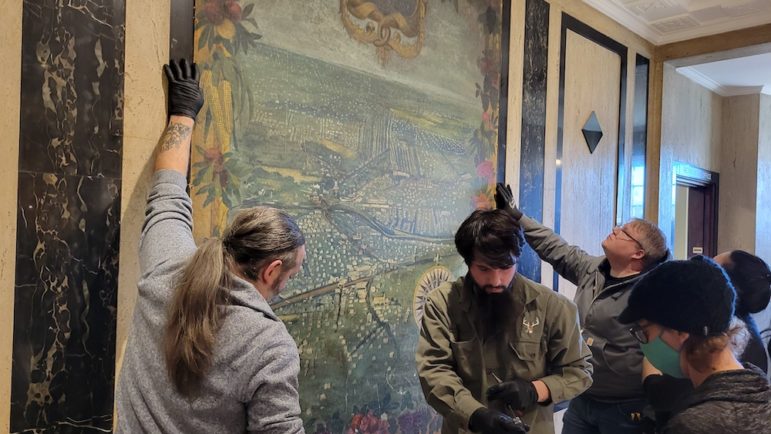
Charlie Breitrose Employees from Maquette Fine Arts Services prepare one of the historic paintings in City Hall’s lobby to be removed from the wall for restoration. Stephen Munroe of Maquette, center, speaks with art preservationist Louise Orsini, right.
Friday morning a quiet sense of anticipation filled the lobby of Watertown’s City Hall. The marble covered atrium was filled with history lovers and art preservationists waiting to see what secrets are held by a pair of paintings dating back to the early 1930s.
The towering paintings have been inset into the walls of Watertown’s Town Hall (since 2021 City Hall) since it opened in 1932. One shows a map of Watertown 300 years after its founding, and the other shows the town as it was laid out when it was founded in 1630.
The artworks show signs of their age, with dirt and grime from nearly a century hanging on the walls, as well as some usual damage suffered over that span. The paintings will be restored as one of Watertown’s first projects using Community Preservation Act funds.
The work on restoring Irving Park got a slight head start on the painting restoration, said Elodia Thomas, a member of the Community Preservation Committee (CPC), but they were the first to projects recommended by the CPC and approved by the City Council.
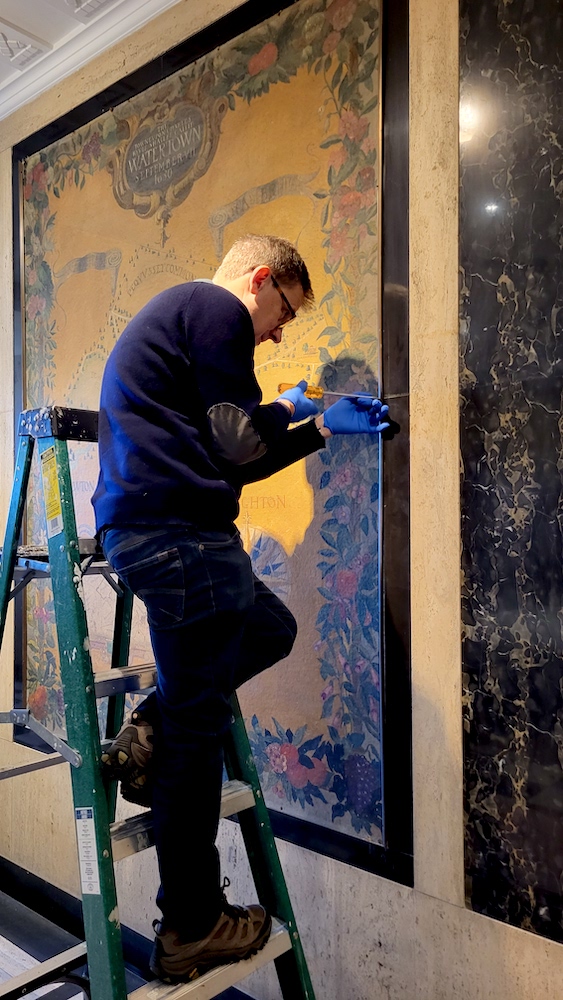
Charlie Breitrose Frame restorer Andrew Haines removes the brass frames from around the painting of the map of Watertown in 1630.
Lanae Handy, Watertown’s Community Preservation Coordinator, also watched intently as the work began. It has been a long time coming, with the CPA passing in November 2016, the CPC being appointed in 2019, the development of the application process and guidelines, and finally the first applications in June 2022.
“So, it is super exciting to finally begin the first project in Watertown CPA,” Handy said.
The Historical Society of Watertown applied for the CPA funding, said Joyce Kelly, a longtime member.
“(Historical Society Board President) Marilynne (Roach) and I have noticed these paintings for years. They’ve been on our radar and noticed they need repair,” Kelly said. “One of them was actually used as a tack board at one point. We’ve noticed they are really dirty and they are really beautiful. They just need a little work.”
Charlie Breitrose
The “1630 to 1930” painting was held in place with dozens of screws, brads and nails. Maquette’s Stephen Munroe removes one of the fasteners. 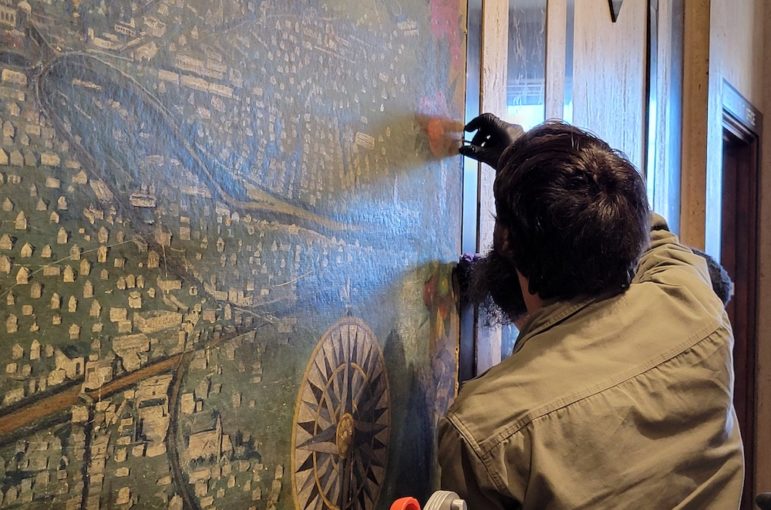
When the work is complete, and the paintings return, Roach hopes the paintings will bring new light to the lobby of City Hall.
“It’s great that (they are) being cleaned and mended where it needs mending, because people haven’t noticed they were here for a long time, I think,” Roach said. “And once they are back to what they looked like when they were new, they’ll notice them more.”
The restoration process will take about a year. Kelly said the Historical Society has several projects in mind for CPA funds, but this project rose to the surface because it is visible and seemed to be simple.
“We thought this would probably be the easiest historic preservation project and it turned out to be many moving parts. It was much more difficult than we realized,” Kelly said.
Charlie Breitrose
Frame restorer Andrew Haines, left, speaks with Watertown Community Preservation Coordinator Lanae Handy and Joyce Kelly of the Historical Society of Watertown. Gail English, Haines’ wife, can be seen behind them. 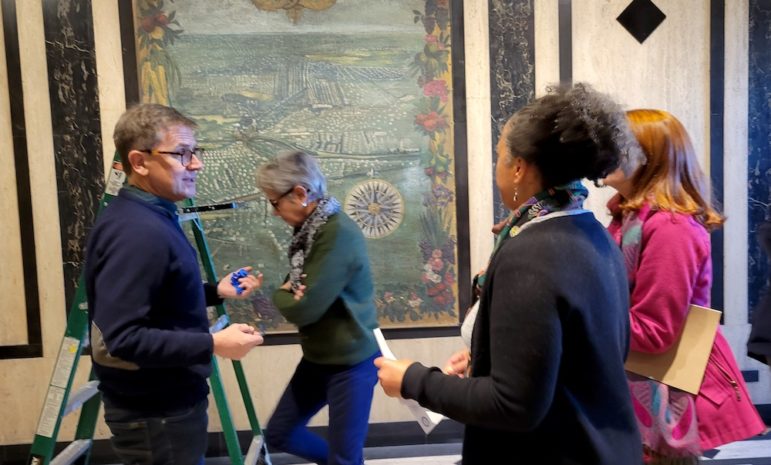
Along with someone to bring the painting back to its original glory, the Historical Society had to find someone to repair and replace the brass frame. Also, a firm had to be found to take the paintings off the wall and transport them to the restoration studio.
“So, there are a whole bunch of moving parts,” said Kelly.
Kelly got a list of conservationists from Boston’s Museum of Fine Arts, and then she made many, many phone calls. She found Louise Orsini, who will restore the paintings. She is a former fellow in paintings conservation at the Harvard Art Museums’ Straus Center for Conservation and Technical Studies, and a former assistant conservator in the Department of Paintings Conservation at the Museum of Fine Arts, Boston.
Orsini will have the paintings delivered to her studio in Malden, where she will come up with a restoration plan.
“I’ve come here before and had an initial look at them, of course, but once I get them to the studio I’ll do a detailed examination,” Orsini said. “General stability is what we address first: the instability of the support around the edges where it is breaking or if there are holes. And then instability in the paint layers. If paint is flaking, I can stabilize that, then I can address the aesthetic issues, which will be a lot of grime removal, and retouching of areas that are scratched or damaged.”
Charlie Breitrose
Some of the damage to the painting of the 1630 Map of Watertown can be seen where the town has been rubbed off the inset map.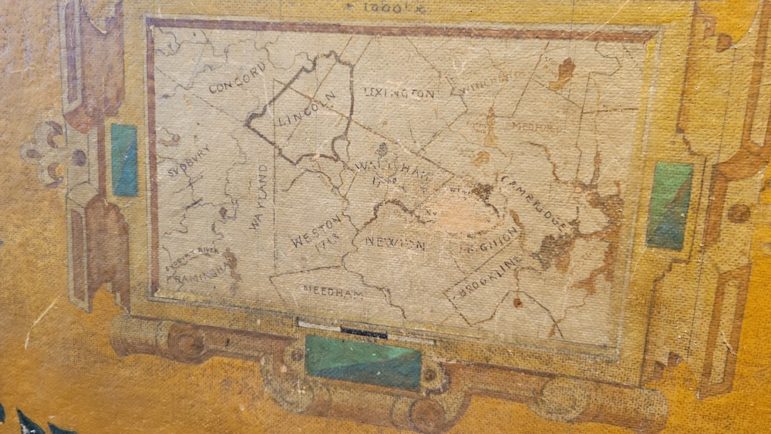
Finding someone to work on the frame proved more difficult, but Orsini had a suggestion.
“I told her that I couldn’t find anybody and she suggested Andy (Haines), who used to work at the MFA also,” Kelly said. “He worked there for 30 years.”
Haines was the MFA’s Associate Conservator, Furniture and Frame Conservation from 2002 until a few years ago when he retired. He has also done frame restoration work for the Worcester Museum of Art, the Kimbell Art Museum in Ft. Worth, Texas, and Princeton University’s museum.
The work at City Hall began with Haines removing the brass frames surrounding the paintings, at least the parts still remaining.
“I will clean up the oxidation, remove the spider webs,” Haines said.
Charlie Breitrose
The crew from Maquette begins to remove the 1630 to 1930 painting from the wall so it can be restored. 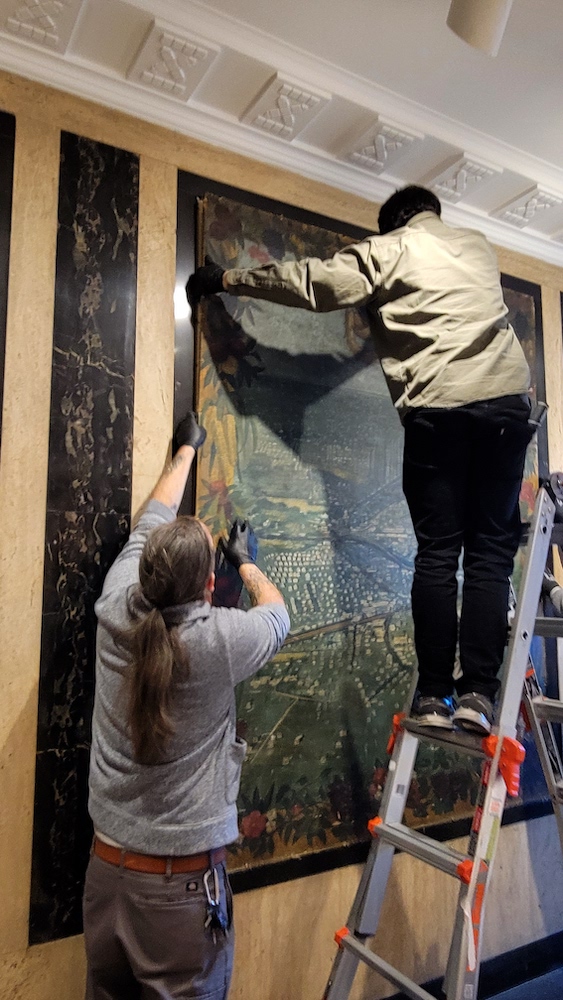
Finding replacements for the brass frame has been difficult, Haines said, because they are not made anymore. Instead he will create replacement pieces out of wood and guild them with copper and gold.
“That should look like brass, and it does tarnish, so that is probably the way to go,” Haines said.
Before the work could begin, the paintings had to be removed from their places inset into the walls of City Hall.
After Haines removed the frames, the folks from fine art logistics company Maquette Fine Arts Services got to work removing the many items holding them in place. There were screws, brads and even nails, along with some wooden pegs placed along the top.
“There were at least 20 screws and nails,” said Stephen Muroe of Maquette, which is based in New York and has a location in Boston that works with variety of places, including the MFA and the Isabella Gardner Museum.
The pieces were painted on a large board made of masonite, a composite material made from small bits of wood compressed together. The edges of the paintings showed signs of damage.
“One had brads and nails,” Munroe said. “I think they noticed it sag overtime.”
The crew from Maquette got up on ladders to ease the “1630 to 1930” painting out of the wall. They had a few false starts when hidden fasteners were discovered. Finally, they tipped it off the wall where it sat for 90 years.
Charlie Breitrose
The 1630 to 1930 painting sits in a foam box that was made to transport the piece to be restored. 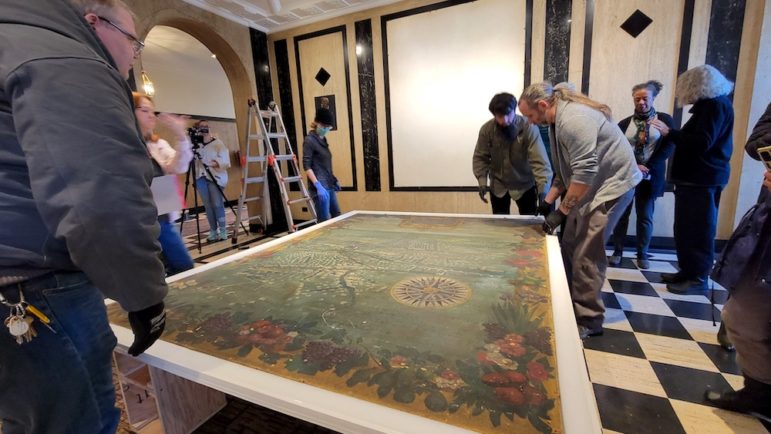
They placed it into a foam frame cut just to size so it fit the painting snuggly. Members of the Historical Society looked on the back, but could find no indication of who had created the piece.
When the other painting, the 1630 map, came down, they found some clues, Kelly said. The names Joyce Hirtle and Gilbert Thomson were written on the back of the painting along with the date March 31, 1932. Kelly did some research and found Joyce Hirtle in a 1938 Watertown resident listing, which listed his occupation. She also and an obituary from 1966.
“Looks like Joyce Hirtle was a carpenter,” Kelly said. “My guess is that he and Gilbert Thomson hung the paintings, but didn’t create them. Darn!”
Joyce Kelly
The names “Joyce Hirtle & Gilbert Thomson” and ,
“March 31, 1932” written on the back of the painting of the 1630 Map of Watertown.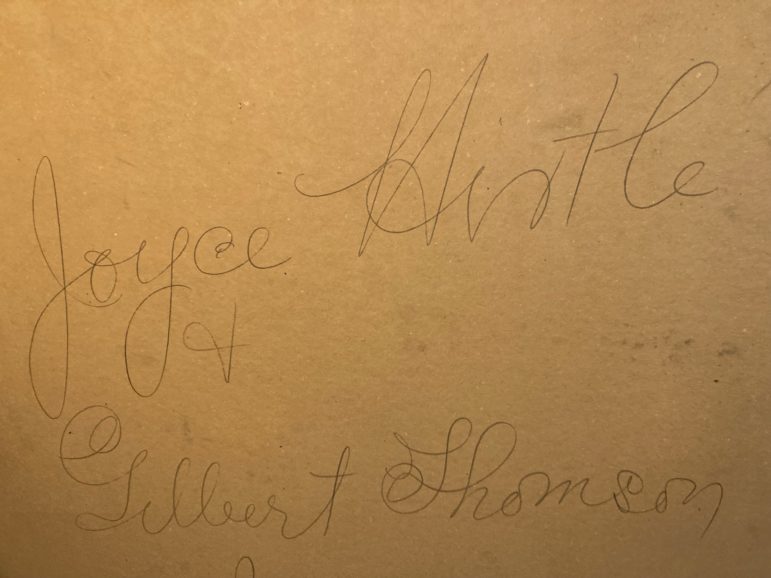
It’s indeed gratifying that the Community Preservation Committee has taken action to preserve and restore these historic works of art.
Fascinating to watch and wonderful knowing that these paintings will soon have the dignity they deserve. Thanks to all who put in a tremendous effort.
When I attended the West Jr in the 1950’s there was a metal shop teacher, Bertram Hirtle.
I would have no way of knowing but possibly he was related to the signator of the back of the
1630-1930 painting.
Jack Watson,
Thanks for that information about your teacher. Bertram Hirtle was Joyce Hirtle’s son.
Jack, that’s great information to help our history detectives. Joyce Kelly and Marilynne Roach from the Historical Society and Lanae Handy, CPC Coordinator are trying to figure out the back story, particularly who commissioned the murals and who painted the murals. As noted in Charlie’s article a team is involved in this restoration – Maquette, the transporters, Louise Orisini, our conservator, and Andy Haines, the frame restorer. Hoping all our Watertown sleuths come up with more answers.
It was super exciting to find the date and names on the back of the mural. As I said to folks, this reminds me of the Geraldo Rivera special regarding the opening of Al Capone’s safe. It seemed to go on for hours: they found nothing. We were lucky and found our first clue. Keep those clues coming! We’ll all celebrate when the restored murals go back up. Thank you.
The Watson’s still remembered well in the Nyack St neighborhood stories, thanks Jack!
THIS detail is what I like about the Watertown News. And kudos to the CPA for their part in this important project.
Has anyone thought about making available smaller copies for residents to enjoy?
Look forward to the News announcement that the paintings have been returned to CITY Hall.
Unfortunately, Bert passed away last year at 100. Wish we knew all this just a year earlier! Bert ended up being our shop/photography and outdoors teacher at Home Base way back when. Thanks for sharing that info!
On a genealogical website I found a great-grandson of Joyce Hirtle’s, who contacted his great-aunt Verne Hirtle, who is Joyce Hirtle’s daughter and Bert Hirtle’s sister. The great-grandson had sent her the article I sent him from Charlie Breitrose’s Watertown News which included the signatures on the back of the painting depicting 1630. Verne she said she recognized her father’s handwriting right away.
She said her father did not paint, but he was a master carpenter. She also remembers that her father had a friend named “Gil”, and it was probably Gilbert Thomson. Gil was also a carpenter. She thinks Gil and her father met in the late 1920s when both lived in Cambridge.
Unfortunately, they are not the artists. But, at least we know that for sure now. And we have a pretty cool story about the 2 carpenters who hung the paintings secretly writing their names on the back and causing quite a stir 90 years later !
We at the Historical Society will get to the Boston Atheneum in the new year and take a look at the architect’s (R. Clipson Sturgis) notebooks. Hopefully there will be some information about the artist in his papers.